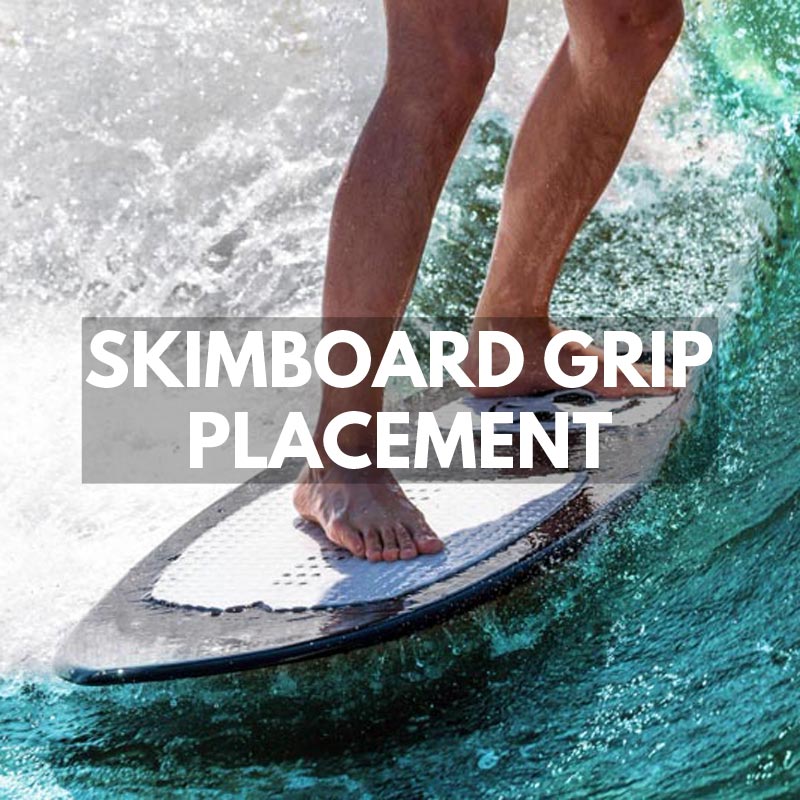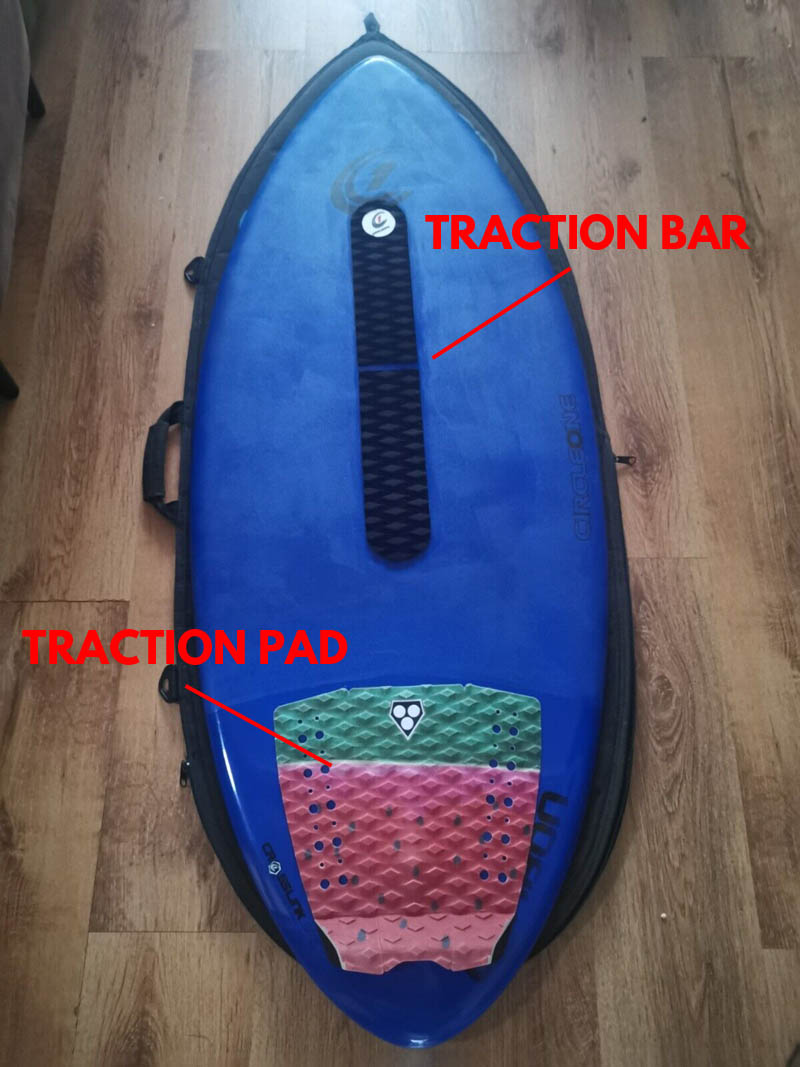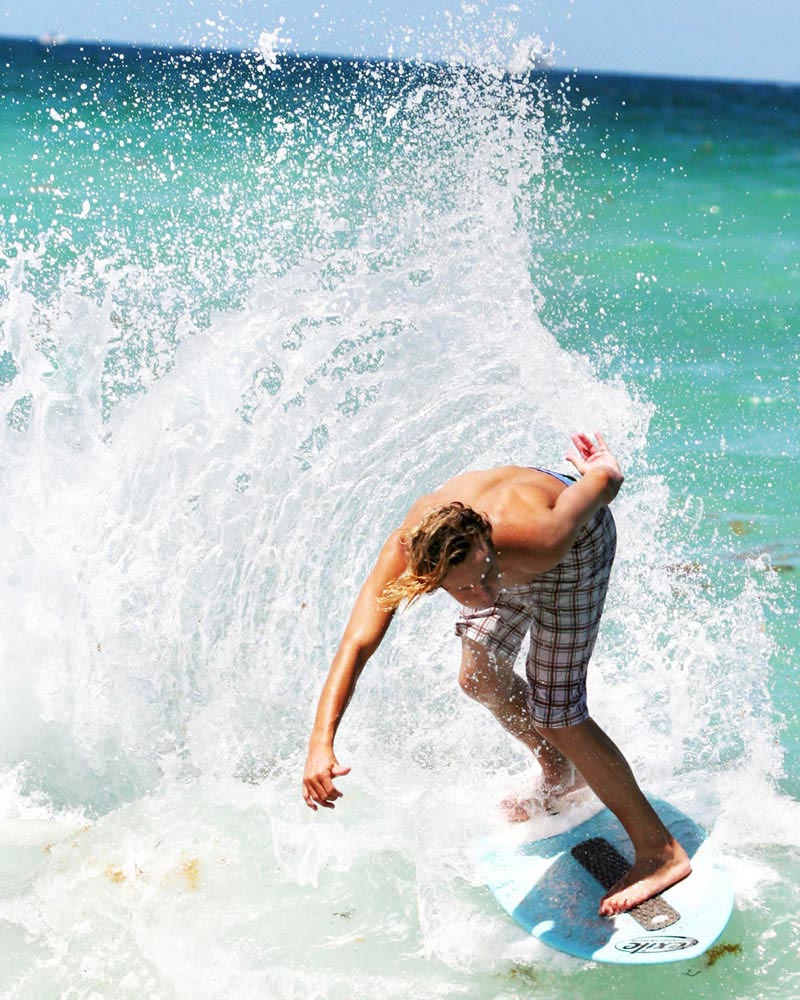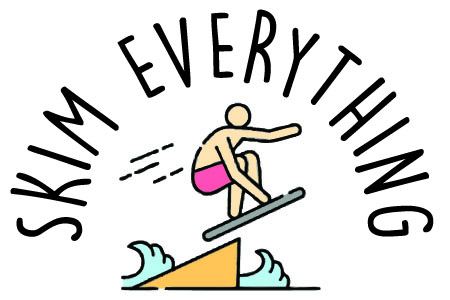
Skimboard Grip Placement: Everything You Need to Know
In this article, we cover everything you need to know for successful skimboard grip placement. You will learn about the different types of grip, exactly where to place traction pads, and whether you need to wax your skimboard as well.
Using grip or traction pads is a personal preference but also depends on a couple of different factors. The type of skimboarding you are doing (flatland, waves, shallows…), how wide your board is, and how big or small your feet all have an influence on the need for more grip.
Traction pads can be spread out and also used in combination with wax. For ocean skimboards, we recommend a tail pad with a raised arch bar. Placed within an inch of the tail edge and aligned with the center line.
What is a Skimboard Traction Pad?
Skimboard traction pads are made from high-density foam or rubber that is specifically formed to give grip on the skimboard. Traction pads are stuck to the board with a peel-back adhesive and allow your feet to hold onto the surface of your skimboard even when wet.
Other names for skimboard traction pads are “tail pads” and “deck grips”. As the name suggests, tail pads are for the rear, whereas deck grip is a generic name for all grips.
On a fiberglass skimboard, it’s common to use a tail pad at the rear of the skimboard. For the front foot, we can use a traction bar, another traction pad, wax… or traction and wax. For plywood skimboards, it is common to have flat traction pads across the deck because plywood skimboards tend to be less directional than fiberglass boards.
2 Piece Traction Pads Vs. 3 Piece Skimboard Grip
The only difference between 2-piece traction pads and 3-piece grips is the ability to spread them out when positioning the grips. Does this difference matter?
For performance, not really. However, the width of your board and the size of your feet may decide this question for you. As long as we have a grip at the arch of our foot, the toes/ball of the foot, and at the heel, we are good to go.
Aesthetics can play a role here. Say we have an awesome paint job on the skimboard, we can let that nice design and color come through by separating the skimboard grip placement.

What is a Skimboard Traction Bar?
A skimboard traction bar also called an “arch bar”, is a narrow strip of traction pad material that is raised in height and sits in the middle of your board. These are amazing because they allow a skimboarder to instantly locate their feet on the centerline of the board and use the arch of their foot for extra grip.
Tail pads can also come with a raised arch for the same reason. Arch bars increase lateral control of the board, which is particularly useful for the rear foot because we are driving our turns and moves largely from the rear foot.
Do You Need Grip Pads On Your Skimboard?
While technically you do not need a grip pad on your skimboard, they are amazingly helpful. You can of course just use wax but you will be missing out on the lateral support and extra grip from arch bars and the instant locating of the center of the board.
For skimboarding on waves, the instant locating effect, leading to good foot positioning, is a must. Therefore it is strongly recommended to use grip pads on your ocean skimboard.
Dedicated flatland skimboards tend to favor flat grip pads over tail pads and arch bars. This is for two reasons. Firstly, flatland skimboarding (urban) is often done with shoes on. Secondly, conversely to ocean skimboards, purpose-built flatland skimboards are designed to also be ridden back-to-front.
Where Should You Put Your Traction Pad and Traction Bar?
Both your traction pad and traction bar should be positioned along the centreline of the board. Most boards will have a faint line running down the middle. Use masking tape from nose to tail to help guide you if your skimboard doesn’t have a visual centreline.
The tail pad grip placement should be within an inch away from the tail edge. If it has multiple pieces, align the center arch bar along the center line of the board, then space out the side pieces symmetrically. Touching the centerpiece or with a gap, is your preference.
Traction bars are usually long enough that longitudinal (nose to tail) grip placement doesn’t matter so much. Stand on your board as you would when skimming, and put the traction bar there under your foot. Not scientific, but it’s all you need.
Note: No need for surgical precision here. If you’re a few millimeters out of position, it won’t matter. Just don’t be 20mm out.
Deciding Where to Place Your Skimboard Grip Pad
If the centerpiece of the grip pad is raised, you must align the center of the raised section with the board’s centerline. Other than that you can decide to place your skimboard grip pads where ever you like. Aerodynamics is not a factor.
Front foot traction pads are often just flat and thus you can decide to put them in any position you feel your foot will need grip.

Should You Wax Your Skimboard Traction Pads?
Initially, you shouldn’t need to wax your skimboard traction pads. But you of course can. This technique is usually used once the traction pads get a bit old and weathered.
You can also glue sand to your traction pads if they become smooth over time.
If waxing the traction pads works for you, then do it. Just clean it all off from time to time with a wax remover so it doesn’t build up and turn the pad into a clogged, hard, horrible thing.
Is Skimboard Grip Placement Different From Surfing Traction Pad Position?
The principles of skimboard grip placement are the same as in surfing. The difference is that surfboards have a few more constraints.
In surfing, there is a leash plug that can make tail pad placement further forward. Surfing tail pads are more so placed relative to the fin position. Skimboards don’t have these constraints.
Preparation Before Placing Your Skimboard Grip in Position
Before placing your skimboard grip in position, the deck must be completely clean and free of wax and old adhesive (if you’re replacing an old grip). Potentially, a light sand with fine sandpaper may be needed to get back to the base material. Or you can try out some surfboard wax removal solution if you are struggling. This will have its own how-to guide on the site soon.
How Far Back Should a Traction Pad Be?
A rear traction pad (tail pad) should be as far back as possible. This will depend on the shape of the tail and the size of the traction pad. Arrange your grip before sticking it down to test different positions, you can use masking tape or a whiteboard marker to provide the template when it comes to sticking them down.
Perfect skimboard grip placement, of the tail pad, should be up to an inch away from the tail edge. Aligned with the center line.
We hope you found all the answers you needed about skimboard grip placement and where to put skimboard traction pads. Feel free to get in touch with any questions.








[…] and a wakeboard is the bindings. Skimboards and wakesurf boards don’t have any. They rely on traction pads and wax for […]